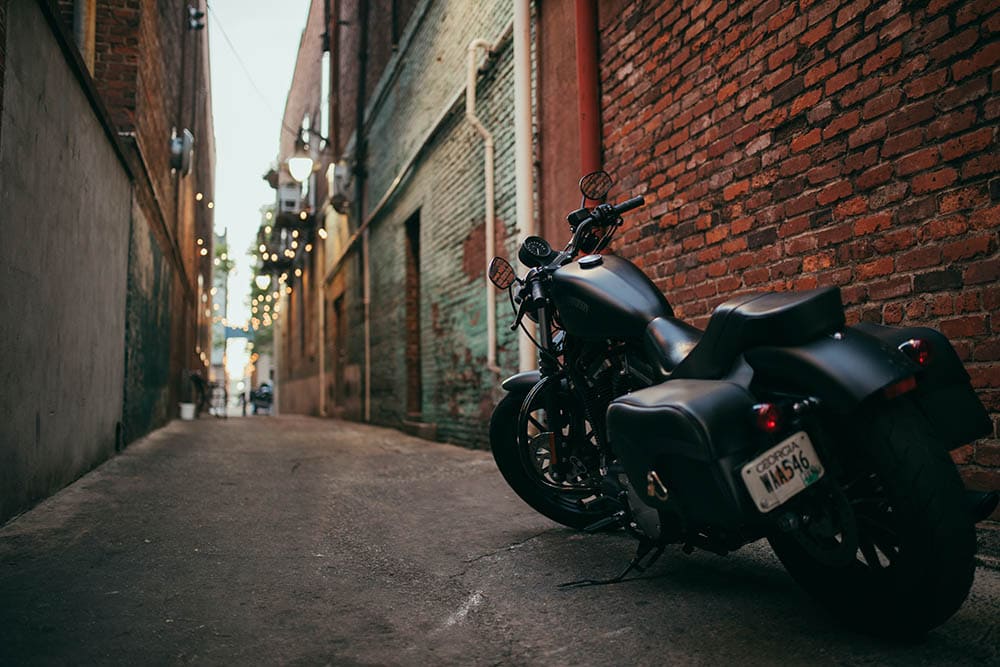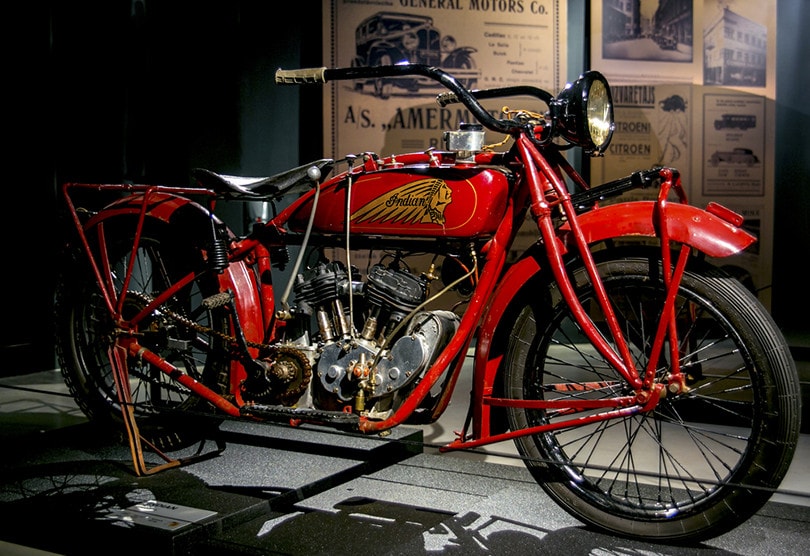5 Types of Cruiser Motorcycles (with Pictures)
-
Ingrid Yeh
- Last updated:

Refined by time, the quintessential style of classic American motorcycles is the cruiser motorcycle. Reminiscent of motorcycles from the 1930s through the 1960s, cruisers’ distinct designs encourage riders to cruise and enjoy the journey, rather than racing to the destination.
Styled with comfort and leisure in mind, the classic cruiser look typically consists of low seats, wide handlebars, and foot pegs geared at the front of the bike—creating a laidback and relaxed riding position. Most cruiser motorcycles are equipped with a V-twin engine, loading them with both speed and power, as well as loud torquey engines.
Birth of the Cruiser
As the first brand to introduce a cruiser motorcycle back in the 1970s, it’s no wonder the name Harley Davidson is so synonymous with the category to this day. European brands like Ducati, Triumph, and BMW, as well as big Japanese names like Honda, Kawasaki, and Yamaha offer cruiser models as well. Even the American brand, Indian, has returned after a long hiatus with cruiser motorcycles of its own.

Cruiser motorcycles come in various shapes and sizes and consist of five different types. Whether you’re in the market for one of your own or you’re just curious to learn more, we’ve got you covered on the different types of cruiser motorcycles, what sets them each apart, as well as important specs to consider.
The 5 Types of Cruiser Motorcycles
1. Entry-Level
As the name suggests, entry-level cruiser motorcycles are an all-around better fit for beginner riders. They are generally smaller and lighter than other cruisers, with smaller displacement engines making them easier to manage for someone just starting off on the road. While only a handful of entry-level cruiser motorcycles are available on the market, they’re generally more accessible price-wise—another considerable plus for beginner riders.
Considering most motorcycle wrecks involve riders within their first six months on the road, it is highly recommended to start off with something smaller and lighter. Because full-size motorcycles are much more difficult to control, leaving a smaller margin of error, starting off with an entry-level bike allows beginners to focus on the primary fundamentals of riding—such as positioning and vision. This gives them the best chance at progressing as a rider without dealing with unnecessary challenges caused by the bike itself.
- Novice-friendly
- Easy and comfortable to ride
- Accessible price range
- Convenient high-tech amenities (e.g., Bluetooth connectivity, GPS, multiple ride modes)
- Few available models on the market
- Not especially fast in terms of top speed
2. Tourer
Tourers are a special breed of cruiser motorcycles. They are best known for their long-distance application, making them ideal for lengthy road trips. They are highly stable due to their massive weight, long wheelbase, and are powered by large engines. Despite being extremely heavy-weight, tourer cruisers can accelerate to impressive highway speeds. While strong, durable, and designed to carry heavy luggage, they are also built for comfort with plenty of accessories to keep riders relaxed for miles and miles on the open road.
- Built for comfort
- Extremely durable
- Versatile with utility features (e.g., electrical charging ports)
- Provide ample storage space
- Large fuel tanks
- Poor maneuverability
- Poor gas efficiency (despite larger fuel tanks)
3. Bagger
Bagger cruiser motorcycles, also known as “dressers”, are instantly recognizable on the road. They feature large fairings and hard luggage, as well as a good-sized pillion, for easy and reliable transporting of both belongings and passengers alike. Like tourer cruisers, baggers are great for long-distance travel. Typical amenities that make baggers so coveted include heated grips, cruise control, GPS navigation, and powerful audio and infotainment systems—all making for the utmost comfort during those long-distance rides.
- Built for comfort, and gear can easily be added to increase comfort and capacity
- Built to last
- Provide ample storage space
- Exude both power and luxury
- Extremely heavy with poor maneuverability
- Can be quite expensive
4. Hyper-cruiser
This subcategory of cruiser motorcycles has been specifically engineered for higher performance than your average cruiser and is appropriately named the hyper-cruiser. Also known as power cruisers, these high-performance cruisers sport upgraded features like an ultra-lean angle, improved acceleration and cornering, and other componentry usually reserved for sport bikes. Though cruiser motorcycles aren’t typically known for being the fastest bikes on the road, hyper-cruisers feature more powerful engines that lend them more speed and power than the average cruiser.
- Upgraded features focused on high-performance
- Faster and more powerful than average cruisers without compromising long-distance comfort
- The only type of cruiser motorcycles that are comparable to sport bikes
- Very expensive
- A lot to manage, not ideal for beginner riders
5. Electric
Although still in its early stages, the electric cruiser motorcycle is quickly catching up to its gas-powered counterparts in terms of quality and performance. With only a few models currently on the market, electric cruisers are indicative of the next big thing for this genre of motorcycles. While they may lack the classic rumble and bark of gas-powered cruisers, they make up for it by featuring the latest cutting-edge technology, while still maintaining an ample amount of low-end torque.
As an electric vehicle, this subcategory of cruisers is not designed for long-distance applications like the others. However, its smooth, quiet, and often powerful nature makes the electric cruiser perfect for city riding, as well as an excellent choice for beginners.
- Electric-powered, no need to fill up on gas
- Very low maintenance
- Feature latest cutting-edge technology and amenities
- Smooth, quiet, and easy to ride
- Not ideal for long-distance trips
- Recharging time and locations are things to consider
- High upfront cost
Key Specs of Cruiser Motorcycles
Just as their name suggests, cruiser motorcycles are designed to emphasize riders’ comfort, making them ideal for commuting, leisure riding and, well, cruising. While there are various types to choose from, most cruiser models follow a similar recipe. As such, there are a few key specifications that help to differentiate them, such as power output, weight, and price.
Power Output
Exactly as it sounds, the power output measures how powerful a motorcycle is. Power output is measured in cubic capacity, or CC for short. The CC is essentially the volume of the bike’s engine chamber, which determines how much power it can produce in the form of horsepower, torque, and mileage. The larger the CC, the higher the power output.
Most cruiser motorcycles have V-twin engines with power outputs ranging between 500 CC all the way up to 1800 CC. Some beginner-friendly cruisers are lower in CC, while others built for size and power are much higher.
Below is a table showing the cruiser motorcycles (with V-twin engines) with the lowest, average, and highest CC currently on the market:
| Cubic Capacity (CC) of Cruiser Motorcycles in 2022 | ||
| CC Ranking | Make and Model | Total CC |
| Lowest | Yamaha V-Star 250 | 249 CC |
| Average | Honda Fury 300 | 1,312 CC |
| Highest | Triumph Rocket 3 | 2,458 CC |
It’s important to note that a cruiser’s power output will directly affect its insurance premium. The higher the bike’s CC, the higher its insurance premium will be, as the anticipated cost for repairs is also higher. This is something to keep in mind when considering the total costs of your cruiser of choice.
Weight
A big part of the appeal of cruiser motorcycles is how big and heavy they are. Cruisers are very much designed to be statement pieces on wheels—making lots of noise, sporting lots of shiny metal, and demanding lots of attention wherever they go. Keep in mind they are specifically built to be stable, powerful, and suitable for prolonged cruising on the highway, versus being light, nimble, and built for high-speed racing.
A cruiser’s heavy weight is mainly due to having a large and heavy twin-cylinder engine that needs a sturdy, just-as-heavy chassis to carry and support it. Not to mention all the other heavy parts that make up a cruiser—fat wheels, shiny exhaust pipes, wide handlebars, etc.
The weight range for cruiser motorcycles is rather expansive, as different brands and types of cruisers are all made differently. Most cruisers weigh between 500-700 lbs, with the average bike weighing in at 593 lbs.
Below is a table of the lightest, average, and heaviest cruiser motorcycles currently on the market:
| Weight of Cruiser Motorcycles in 2022 | ||
| Weight ranking | Make and Model | Weight (in lbs) |
| Lightest | Yamaha V-Star 250 | 324 lbs |
| Average | Suzuki Boulevard M50 | 593 lbs |
| Heaviest | BMW R18 Classic | 805 lbs |
Price
Whether looking for a smaller novice-friendly first cruiser or a classic ground pounder, you can expect to pay a pretty penny. New cruiser motorcycles can cost anywhere from $4,400 to $24,000, averaging around $12,100. Bikes at the lower end of this spectrum are typically entry-level cruisers with smaller engines and less power output. Exact pricing largely depends on the specs, as well as the make and model, of the bike you’re looking for.
Below is a table of motorcycle cruisers with the lowest, average, and highest MSRP currently on the market:
| Price of Cruiser Motorcycles in 2022 | ||
| Price ranking | Make and Model | MSRP (in USD) |
| Lowest | 2022 Yamaha V-Star 250 | $4,499 |
| Average | 2022 Indian Scout | $11,999 |
| Highest | 2022 Harley Davidson Softail Heritage Classic | $20,799 |
Conclusion
Nothing embodies being wild and free on the open road quite like a cruiser motorcycle. These rugged road machines are nostalgic of the past while also continuously evolving with the times. With such a consistently relaxed cool factor across various cruiser makes and models, being able to distinguish key differences between each type, as well as important specs to consider, will help you pick the perfect one for you.
Featured Image Credit: Michael Wade, Unsplash
Contents

